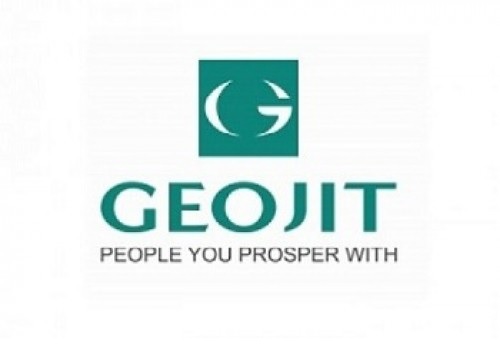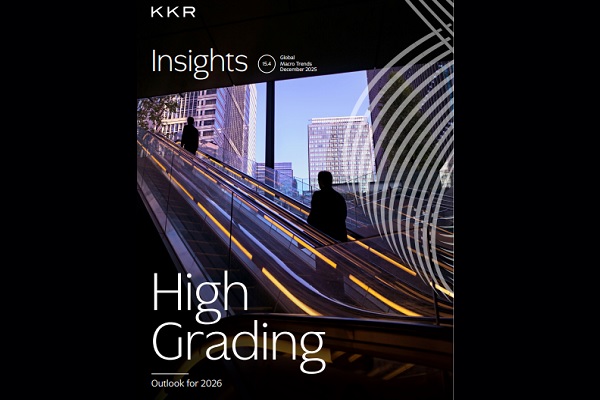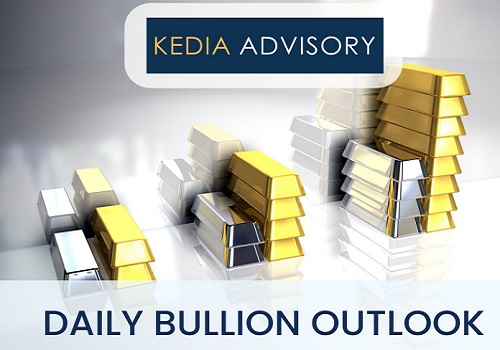Cottoncandy trading range for the day is 55300-55300 - Kedia Advisory

Gold
Gold yesterday settled higher by 1.09% at Rs.96,025 amid heightened uncertainty surrounding US-China trade relations. China's clarification that it is not engaged in trade talks with the U.S., despite claims from U.S. leadership, contributed to safe-haven buying. Meanwhile, a stronger U.S. dollar, typically a headwind for gold, was overshadowed by the geopolitical tensions and investor risk aversion. In China, gold consumption fell 5.96% year-on-year to 290.492 tonnes during Q1 2025, primarily due to surging prices affecting jewellery demand, which slumped 26.85%. However, investment demand surged, with gold bars and coins consumption rising 29.81%, indicating a clear shift toward safe-haven assets amid economic and political uncertainty. China’s total gold imports via Hong Kong rose 41.9% in March compared to February, reflecting renewed investor interest. Meanwhile, gold discounts in India widened to a near nine-year high of $80 an ounce as high domestic prices deterred buyers ahead of the Akshaya Tritiya festival, while Chinese premiums spiked to their highest level in over a year. India's gold demand in 2025 is expected to moderate slightly from last year's nine-year high, ranging between 700 and 800 metric tonnes, largely due to softer jewellery demand but robust investment inflows into ETFs, digital gold, and coins. Technically, the gold market is witnessing fresh buying interest, supported by a 2.75% rise in open interest to 17,848. Currently, gold has strong support at ?94,750, and a break below could see a test of Rs.93,475. Resistance is pegged at Rs.96,695, with a potential move toward Rs.97,365.
Trading Ideas:
* Gold trading range for the day is 93475-97365.
* Gold fell amid easing trade tensions between the U.S. and China.
* China has exempted some U.S. imports from its 125% tariffs.
* China gold consumption in Q1 falls 6% to 290.492 metric tons
Silver
Silver yesterday settled marginally higher by 0.04% at Rs.97,712 as investors tracked developments in global tariff negotiations and anticipated a busy week of critical economic data releases. Optimism emerged after U.S. President Donald Trump signaled openness to reducing Chinese tariffs, while China exempted some U.S. goods from its steep 125% levies. Meanwhile, investors awaited U.S. GDP, PCE inflation, and jobs data that could influence expectations for early Federal Reserve rate cuts. China's cautious approach to new economic stimulus despite confidence in hitting its 5% growth target also added to market sentiment. From a broader perspective, silver is projected to remain in a supply deficit for the fifth consecutive year in 2025. Industrial demand, the primary driver, is expected to reach new record highs, bolstered by structural growth in green energy applications. Total global silver demand is forecasted to stay around 1.20 billion ounces, with industrial fabrication growing by 3%, exceeding 700 million ounces for the first time. However, jewelry and silverware demand are expected to decline, particularly in India due to high domestic prices. Technically, silver is seeing fresh buying interest, indicated by a significant 17.06% rise in open interest to 11,442 contracts. Prices gained 41 rupees, and silver now finds support at Rs.96,990, with a potential test of Rs.96,275 if selling pressure resumes. On the upside, resistance is seen at Rs.98,140, and a break above could push prices toward Rs.98,575.
Trading Ideas:
* Silver trading range for the day is 96275-98575.
* Silver steady as investors eye tariffs, await key economic data this week.
* China expressed confidence in meeting its full-year growth target of around 5% but refrained from introducing immediate stimulus.
* US President Donald Trump signaled openness to lowering Chinese tariffs, while Beijing exempted certain US goods from its 125% levies.
Crude oil
Crude oil yesterday settled lower by -2.13% at Rs.5,281 as market sentiment remained pressured by ongoing uncertainties surrounding U.S.-China trade negotiations and concerns over global economic growth and fuel demand. Additionally, the prospect of OPEC+ potentially raising output at their upcoming May 5 meeting added to bearish sentiments. Some OPEC+ members are expected to propose accelerating production hikes for a second consecutive month. Meanwhile, nuclear talks between Iran and the U.S. continued in Oman, with Iranian officials remaining cautious about a positive outcome, which also weighed on oil prices. U.S. crude oil stocks unexpectedly rose by 244,000 barrels for the week ending April 18th, against market expectations of a 700,000-barrel draw, marking the fourth consecutive weekly build. However, gasoline and distillate fuel inventories showed significant declines of 4.5 million and 2.3 million barrels respectively, offering some support. At the same time, the IEA projected a global oil surplus of about 600,000 barrels per day this year, with a potential increase if OPEC+ accelerates its output hike. The IEA also cut its 2025 oil demand growth forecast by 70,000 barrels per day to around 1 million bpd, citing weak macroeconomic conditions and lower-than-expected consumption. Technically, crude oil markets are under fresh selling pressure, with a 5.72% rise in open interest to 14,217 contracts, reinforcing bearish momentum. Prices are now supported at Rs.5,216, and a breakdown below could test Rs.5,152. On the upside, resistance is placed at Rs.5,391, with a potential rally towards Rs.5,502 if buyers regain strength.
Trading Ideas:
* Crudeoil trading range for the day is 5152-5502.
* Crude oil prices declined amid US-China trade uncertainty.
* Fears grow over global growth and weaker fuel demand.
* OPEC+ may propose a second consecutive output hike on May 5.
Natural gas
Natural gas prices surged 7.08% yesterday, settling at Rs.286, driven by forecasts of higher demand this week compared to earlier expectations. However, gains remained capped by the rising output and forecasts of milder weather through mid-May, which are expected to limit heating and cooling needs, allowing utilities to inject more gas into storage. Following a colder-than-expected winter that left storage 1% below seasonal norms, April has seen average gas production in the Lower 48 states rise to 106.5 bcfd, surpassing March’s record. Fundamental data reflects the impact of elevated production levels, as U.S. utilities added 88 bcf to storage for the week ending April 18th, significantly above the expected 65 bcf and marking the largest build in nearly a year. Nevertheless, inventories remain 19.8% above year-ago levels and just 2.2% below the five-year average. Regionally, the South Central and Midwest saw the most significant stock increases. Meanwhile, the U.S. Energy Information Administration (EIA) expects both output and demand to reach record highs in 2025, with dry gas production projected at 104.6 bcfd and LNG exports forecasted to grow to 14.0 bcfd, underpinning long-term bullish sentiment. Technically, the market is experiencing short covering, evidenced by a 12.04% drop in open interest to 11,985 contracts while prices rose by Rs.18.9. Natural gas finds immediate support at Rs.268.6, with further downside risk toward Rs.251.2, while resistance is placed at Rs.295.3, with a potential extension to Rs.304.6 on continued buying momentum.
Trading Ideas:
* Naturalgas trading range for the day is 251.2-304.6.
* Natural gas gained on forecasts for higher demand this week than previously expected.
* However upside seen limited on rising output and forecasts for mild weather through mid-May.
* Average gas output has risen to 106.5 bcfd in April from a monthly record of 106.2 bcfd in March.
Copper
Copper yesterday settled marginally lower by -0.09% at Rs.854.35 as the market remained cautious, awaiting fresh developments in U.S.-China trade relations and economic signals from China. Growth concerns loom large amid the impact of new U.S. import tariffs, potentially dampening copper demand. However, the downside was limited by a substantial drop in inventories at the Shanghai Futures Exchange (ShFE), where stocks plunged by 32% to 116,753 tons last week. This drawdown reflects Chinese consumers increasingly relying on refined copper due to a shortage of scrap supplies. According to the International Copper Study Group (ICSG), the global refined copper market posted a surplus of 61,000 metric tons in February, slightly lower than January’s 90,000 metric tons surplus. Cumulatively, the first two months of 2025 recorded a surplus of 150,000 metric tons, compared to 157,000 metric tons in the same period last year. On the production side, February's world refined copper output was 2.20 million metric tons against a consumption of 2.14 million metric tons. Meanwhile, China's imports of unwrought copper and copper products fell 1.4% year-on-year to 467,000 metric tons in March, with Q1 imports down 5.2% to 1.37 million tons. Technically, copper remains under fresh selling pressure, with a 4.27% increase in open interest to 7,443 contracts while prices slipped by Rs.0.75. Immediate support is seen at Rs.850, and a break below could lead to a test of Rs.845.7. Resistance is now at Rs.857.4, with a potential move toward Rs.860.5 if buying resumes.
Trading Ideas:
* Copper trading range for the day is 845.7-860.5.
* Copper dropped as the market waited for further developments on U.S.-China trade relations.
* World refined copper market in 289,000 t surplus in 2025; 209,000 t surplus in 2026 – ICSG
* However, downside seen limited amid a massive drop in SHFE inventories, dropped 32% last week to 116,753 tons.
Zinc
Zinc prices settled lower by 0.36% at Rs.250.85 yesterday, weighed down by lingering concerns over fragile U.S.-China trade negotiations. Although China's move to exempt certain U.S. imports from tariffs hinted at easing tensions, uncertainty continues to cap any significant market optimism. Meanwhile, zinc inventories tracked by the Shanghai Futures Exchange fell sharply by 12.3% from last Friday, providing some underlying support to prices. Fundamentally, the global zinc market deficit narrowed to 10,000 metric tons in January from 41,100 tons in December. Production cuts announced by Nyrstar at its Hobart operations, affecting 25% of output, and expected slowdown at Alaska’s Red Dog Mine, a key supplier, are notable supply-side developments. Despite these cuts, the International Lead and Zinc Study Group (ILZSG) expects the refined zinc market to move into surplus in 2025, with output growth of 1.8% to 13.73 million tons, outpacing a modest 1% demand rise. Mined zinc production is forecast to rebound by 4.3% this year. In China, refined zinc output rose significantly in March, up nearly 14% month-on-month and over 4% year-on-year, driven by higher zinc concentrate treatment charges, firm sulphuric acid prices, and increased post-holiday production. Technically, zinc is under fresh selling pressure, with a 9.66% rise in open interest to 2,781 contracts while prices fell Rs.0.9. Immediate support is seen at Rs.249.4, with further weakness toward Rs.247.9 possible, while resistance is pegged at Rs.251.9, with a break higher likely to test Rs.252.9.
Trading Ideas:
* Zinc trading range for the day is 247.9-252.9.
* Zinc dropped amid concerns over the fragile negotiations between U.S.-China trade tensions lingered.
* China's refined zinc production in April 2025 to increase by 4% MoM and over 12% YoY
* The global refined zinc market will be in surplus this year - ILZSG
Aluminium
Aluminium prices settled lower by 0.28% at Rs.234.55 yesterday, pressured by a strengthening U.S. dollar and lingering concerns over global economic growth. Sentiment was slightly buoyed by comments from PBoC Governor Pan Gongsheng, who reiterated China's commitment to maintaining an “appropriately loose” monetary policy to support economic stability. Meanwhile, signs of easing U.S.-China tariff tensions provided some relief, although uncertainty persists after conflicting statements from U.S. President Donald Trump and Chinese officials regarding ongoing trade negotiations. On the supply side, global primary aluminium output rose by 2.3% year-on-year to 6.227 million tonnes in March, with China’s production increasing by 4.4% to 3.75 million tonnes. China's annualized aluminium production hovered close to the 45-million-ton cap set in 2017, indicating ample supply. Meanwhile, aluminium stocks at three major Japanese ports fell 1.2% to 309,700 metric tons by the end of March, and Shanghai Futures Exchange aluminium inventories declined 6.2% last week, highlighting some tightening in available supply. However, Goldman Sachs cut its aluminium price forecast for Q3 2025 to $2,000 per metric ton, citing weaker global growth prospects and increased output from key producers in Guinea, Australia, and China. Technically, aluminium is under fresh selling pressure as open interest rose by 4.46% to 5,013 contracts while prices slipped Rs.0.65. Immediate support is at Rs.233.7, and a break below could lead to a test of Rs.232.6. Resistance is seen at Rs.235.5, and a move above this level could push prices toward Rs.236.2.
Trading Ideas:
* Aluminium trading range for the day is 232.6-236.2.
* Aluminium dropped weighed down by jump in the dollar, fuelled by the signs of easing tariff tensions.
* China's primary aluminium production grew by 2.6% year-on-year in the first quarter of 2025 - IAI
* Aluminium inventories in warehouses monitored by the Shanghai Futures Exchange fell 6.2%
Cottoncandy
Cottoncandy prices declined by 0.36% yesterday, settling at Rs.55,300 amid profit booking, following recent gains driven by supply concerns. The Cotton Association of India (CAI) further trimmed its domestic crop forecast by 4 lakh bales to 291.30 lakh bales of 170 kg each, citing lower production in Maharashtra. Total cotton supply till March, including 25 lakh bales of imports and 30.19 lakh bales of opening stocks, was estimated at 306.83 lakh bales. End-March stocks were reported at 127.83 lakh bales, with a significant portion held by CCI, Maharashtra Federation, and traders. On the trade front, India’s cotton exports for the 2024–25 season are projected sharply lower at 16 lakh bales compared to 28.36 lakh bales in the previous year, while imports are forecast to more than double to 33 lakh bales, up from 15.20 lakh bales last season. The rise in import estimates is driven by expectations of tighter domestic availability, despite stable consumption levels. However, mill buying remains muted due to ample stocks, limiting upside potential. Internationally, the U.S. cotton balance sheet for 2024–25 saw minor adjustments, including a cut of 100,000 bales in exports and a corresponding increase in ending stocks to 5 million bales. Global production and consumption were both lowered, raising ending stocks, with notable declines in Argentina and Indonesia partially offset by gains in China and Turkey. Technically, Cottoncandy is experiencing fresh selling pressure, with open interest rising 0.4% to 254 contracts as prices dropped by Rs.200. Immediate support lies at Rs.55,300, with resistance also at Rs.55,300; a breakout could see prices testing higher levels.
Trading Ideas:
* Cottoncandy trading range for the day is 55300-55300.
* Cotton dropped on profit booking after prices gained as CAI expects a shrinkage in the domestic crop
* CAI has estimated the total cotton supply till the end of March including the imports at 306.83 lakh bales.
* Cotton exports for the 2024-25 season are pegged at 16 lakh bales, lower by 12.36 lakh bales
* In Rajkot, a major spot market, the price ended at 25982.3 Rupees dropped by -0.05 percent.
Turmeric
Turmeric yesterday settled down by -1.57% at 14,004 amid weak domestic demand and sluggish export enquiries, despite adequate supplies in the market. Total arrivals across key markets were reported at 51,732 bags, significantly lower compared to 74,059 bags in the previous session, indicating some supply pressure easing. In Sangli, one of the main producing regions, arrivals have dropped to about 7.0 lakh bags compared to 7.2 lakh bags last year, reflecting concerns of lower-than-expected production this season. Although the area under turmeric cultivation has increased by 10% to 3.30 lakh hectares, productivity is likely to be impacted by untimely rains, with expectations that overall yields will be 10–15% lower, especially in regions like Nanded where crop damage and small rhizome growth have been reported. On the export front, turmeric exports between April–January 2025 rose by 12.93% to 148,690.78 tonnes compared to the same period a year earlier. However, month-on-month, January 2025 exports were down 23.17% from December 2024, though still 12.18% higher compared to January 2024. Imports rose sharply by 70.13% over the same April–January period, although January 2025 saw a steep decline both month-on-month and year-on-year. In Nizamabad, a major spot market, turmeric prices dropped by -1.79% to 14,622.3 rupees. Technically, the market is under long liquidation, with open interest falling by -1.18% to 14,280. Turmeric is finding support at 13,786, and a break below could see a test of 13,570. Resistance is now seen at 14,284, with a move above likely to lead to a test of 14,566.
Trading Ideas:
* Turmeric trading range for the day is 13570-14566.
* Turmeric dropped due to weak domestic demand and weak export enquiries.
* Arrivals in key markets dropped to 51,732 bags from 74,059 the previous session
* Lingering worries over slow rhizome growth and low yields limited further downside in prices.
* In Nizamabad, a major spot market, the price ended at 14622.3 Rupees dropped by -1.79 percent.
Jeera
Jeera yesterday settled down by -1.02% at 22,315 as comfortable supplies and subdued export demand kept prices under pressure. Total arrivals in Gujarat were reported at 27,300 bags (55 kg each), up from 24,000 bags in the previous session, contributing to the downward pressure. Although supplies from Rajasthan remain tight, the near-term trend shows adequate availability, especially as the new crop arrivals in Gujarat have been delayed by about a month due to unfavorable weather during the sowing season. Farmers are estimated to be holding around 20 lakh bags of cumin, of which only 3–4 lakh bags are expected to be traded by season’s end, implying a heavy carry-forward stock of around 16 lakh bags. Despite the current demand weakness, jeera exports during April–January 2025 rose sharply by 66.98% to 182,167.70 tonnes compared to 109,097.06 tonnes in the same period a year earlier. However, on a monthly basis, January 2025 exports dropped by 5.50% compared to December 2024, though they were still 37.82% higher than in January 2024. On the import side, jeera imports during April–January 2025 plummeted by 93.84% to just 1,071.91 tonnes, highlighting a strong domestic supply scenario. In Unjha, a major spot market, jeera prices closed lower by -0.39% at 23,043.4 rupees. Technically, the market remains under long liquidation with open interest dropping by -12.6% to 4,911. Jeera is getting support at 22,140, with a break below potentially testing 21,960 levels, while resistance is seen at 22,610, and a move above could lead to a test of 22,900.
Trading Ideas:
* Jeera trading range for the day is 21960-22900.
* Jeera dropped due to comfortable supplies and tepid export interest.
* Gujarat saw 27,300 bags arrive, up from 24,000 bags, exerting further downward pressure.
* Supply trends remain crucial, as near-term supplies remain tight due to limited arrivals from Rajasthan.
* In Unjha, a major spot market, the price ended at 23043.4 Rupees dropped by -0.39 percent.
Views express by all participants are for information & academic purpose only. Kindly read disclaimer before referring below views






















